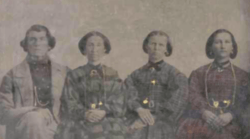Short Creek Community
| Short Creek Community | |
|---|---|
| Community | |
|
| |
| Coordinates: 36°59′22″N 112°58′41″W / 36.98944°N 112.97806°WCoordinates: 36°59′22″N 112°58′41″W / 36.98944°N 112.97806°W | |
| Founded | 1913 |
| Time zone | MST (UTC-7) |
The Short Creek Community (now Colorado City, Arizona, and Hildale, Utah), founded in 1913, began as a small ranching town in the Arizona Strip.[1] In the 1930s it was settled by Mormon fundamentalists, who remain there to this day.
History
In May 1935, members of the Council of Friends, a breakaway group from the Salt Lake City-based The Church of Jesus Christ of Latter-day Saints (LDS Church), sent a handful of followers to the Short Creek Community with the express purpose of building "a branch of the Kingdom of God."[2] Barlow believed that the isolated Creek could provide a place of refuge for those engaging in the covert practice of polygamy, a felony; within a month, the town's population more than doubled. The Council of Friends membership desired a remote location where they could practice plural marriage, which had been publicly abandoned by the LDS Church in 1890.
On July 26, 1953, Arizona Governor John Howard Pyle sent troops into the settlement to stop polygamy in what became known as the Short Creek raid. The two-year legal battle that followed became a public relations disaster that damaged Pyle's political career and set a hands-off tone toward the town in Arizona for the next 50 years. The Fundamentalist Church of Jesus Christ of Latter Day Saints (FLDS) later developed in the same geographical region and changed the name to Colorado City and Hildale to eliminate any ties to the Short Creek raids.[1]
Council of Friends
| Mormonism and polygamy |
|---|
 Portrait of Ira Eldredge with his three wives: Nancy Black Eldredge, Hannah Mariah Savage Eldredge, and Helvig Marie Andersen Eldredge. |
|
Related articles |
|
|
The concept of a Council of Friends or Priesthood Council was central to the Mormon fundamentalist theology developed by Lorin C. Woolley and others in the Short Creek Community. The Short Creek Community was home to this council starting in the late 1920s. Since the authority of the Council of Friends pertained to the Priesthood and not to the Church, early Mormon fundamentalists, most of the residents of Short Creek Community had been excommunicated from the LDS Church. They felt that the existence of the Council of Friends gave them the right to continue solemnizing plural marriages even after Church President Wilford Woodruff's 1890 Manifesto discountenancing the practice.
Short Creek Community leadership
The following are the leaders of the Council of Friends, and as such were also leaders in the Short Creek Community.[3][4][5]
- John W. Woolley (1918–28)
- Lorin C. Woolley (1928–34)
- J. Leslie Broadbent (1934–35)
- John Y. Barlow (1935–49)
- Joseph W. Musser (1949–54)
- Charles Zitting (1954)
See also
References
- 1 2 Zoellner, Tom (June 28, 1998), "Polygamy: Throughout its history, Colorado City has been home for those who believe in virtues of plural marriage", The Salt Lake Tribune, p. J1, Archive Article ID: 100F28A4D3D36BEC (NewsBank), archived from the original on 2000-05-05
- ↑ Diary of Joseph Lyman Jessop, vols. 1-3 (privately published, 2000).
- ↑ Hales, Brian C (2009). "Questions regarding the described 1886 ordinations". MormonFundamentalism.com. Retrieved 1 April 2010.
- ↑ "Official website of the Fundamentalist Church of Jesus Christ of Latter-Day Saints". The Fundamentalist Church of Jesus Christ of Latter-Day Saints. 2008. Retrieved 1 April 2010.
- ↑ Hales, Brian C (2009). "Fundamentalist leadership succession chart". MormonFundamentalism.com. Retrieved 1 April 2010.